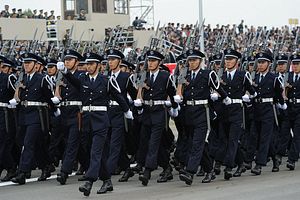In 2015, Japan’s census confirmed that its population had decreased for the first time since the government began counting in 1920. The population decline will obviously have severe economic consequences as fewer workers support a benefits system for the growing number of retirees. But there are concerns for national security too: Japan’s Self-Defense Forces (SDF) may face a serious recruitment problem.
The number of 18- to 26-year-olds – the ages eligible for SDF recruitment – has been falling since 1994. In 2015, there were 11 million in this age group, down about 40 percent from 1994, according to the Ministry of Defense’s annual white paper in 2016. This shrinking pool is the biggest pressure on the SDF’s staffing efforts. A review of the white papers over the past three decades shows that though numbers of applicants and recruits have fluctuated over the years, the staffing rate — the actual number of personnel compared to the authorized level — has been consistently low. The total staffing rate has hovered between 85-95 percent. Non-career personnel, who serve a two- or three-year fixed term, have had much lower staffing rates, in the 60-80 percent range, with few exceptions. These rates suggest that recruiters have accepted long-term understaffing. But as the recruitment age bracket continues to dwindle, simply maintaining the current non-career staffing rate of 75 percent will be more difficult.
More severe staffing shortages in the future will adversely impact the SDF’s defense duties as well as disaster relief and peacekeeping operations. While technology can sometimes reduce staffing needs, widespread introduction of unmanned and autonomous systems will still require humans to perform core functions, as well as maintenance. In addition, a greater portion of personnel will also need specialized skills and knowledge for working with technology. Recruiting such abilities from the ever-smaller eligible age group will be a challenge, especially when competing with private sector opportunities.
In addition to traditional defense, SDF units have participated in dozens of disaster relief and peacekeeping operations, areas in which technology like unmanned aircraft can streamline activities and reduce human involvement in dangerous tasks. SDF activities frequently include medical assistance and transport for disaster relief, and infrastructure development, such as building roads, and transport in peacekeeping operations. The number of SDF personnel for each activity varies, with as many as 1,170 sent to the Philippines after Typhoon Haiyan in 2013 for medical assistance and air support and 2,287 personnel working on infrastructure while peacekeeping in Timor-Leste from 2002-2004. Most activities involve several dozen to several hundred personnel.
It is possible that if fewer SDF personnel are available in the future, units could automate some of their duties. But tasks like medical assistance cannot always be dropped from a drone, especially if delivery of aid requires training. Ominously, the 2016 defense white paper reported that staffing of medical officers was at only 80 percent, because of insufficient training and practice opportunities within the SDF for these officers. Should medical officer staffing continue to fall, the SDF’s medical activities will certainly be curtailed.
Even if technology does allow the SDF to trim its staff, the defense budget has historically been low, with an informal ceiling of 1 percent of GDP. Though Prime Minister Shinzo Abe has decided to consider increasing the defense budget and the LDP might up defense spending to NATO’s 2 percent, it might be difficult politically to raise defense spending enough to purchase the latest technology (and pay for its ongoing maintenance) to allow a smaller SDF to maintain its capabilities. Population decline will also slow economic growth, leading to smaller annual budget increases. As its population continues to age and increase retirement and healthcare costs, the Japanese government will face a balancing act between fielding sufficient defense capabilities and providing for its citizens social and economic needs.
Despite these obstacles, the Japanese government and the SDF must pursue innovative solutions for recruitment issues. The population trend will not be reversed in the short or mid-term, so the constraints on staffing – as well as the budget – must be accepted as the conditions under which the SDF will pursue its missions. Rather than simply leaning more on the United States’ defense commitments and reducing SDF disaster relief and peacekeeping work, the SDF should creatively examine its force size, structure, and capabilities. By discussing what the future SDF will look like, present SDF officers can determine recruitment and acquisition requirements, and develop methods for achieving them.
Pam Kennedy is a Research Associate with the East Asia Program at Stimson.

































